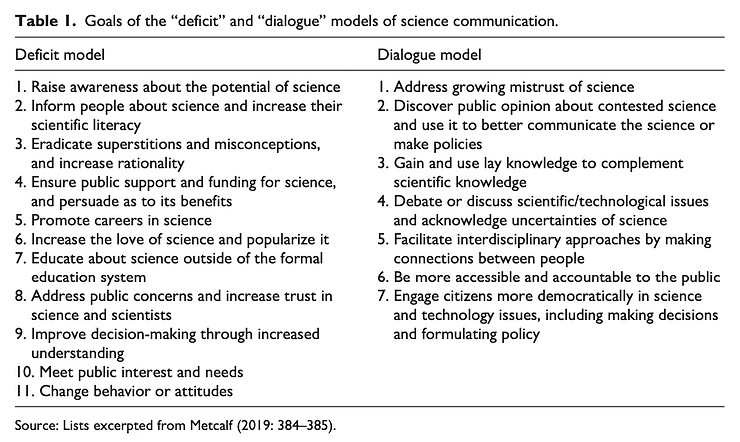What’s Backstage: Looking Beyond Audience and Scientist in Shaping SciComm
By Kay McCallum
Title: “Examining science communication on Reddit: From an “Assembled” to a “Disassembling” approach”
Author(s) and Year: Michelle L. Edwards and Caden Ziegler, 2022
Journal: Public Understanding of Science (closed-access)
| TL;DR: We know that scicomm is influenced by more than just the science we communicate – but as it turns out, even the forum, the facilitators, and the people we don’t directly address as our audience can have an impact in the way our message is conveyed. Why I chose this paper: As a former theatre kid, live theatre is tenuously consistent – even just something like the energy of a crowd can change how a production feels from night to night, and the presence of cameras can create minute differences between a professional recording and the live show. I find it really interesting to consider scicomm as performance in this way, and think about the behind-the-scenes work that make scicomm possible and how audiences get to interact with content both in the moment and as a historical record. |
Every good science communicator has, at least once, critically examined the way they communicate science. You might’ve scoured your work for jargon or tailored your message for a target audience. You might’ve chosen a means of communication that best conveys your message. You might’ve considered how our worldviews shape both the way you communicate science and how your audience receives it.
But have you considered everyone else involved in shaping your science communication?
In an assembled approach to understanding science communication, we focus on how our message is conveyed to our target audience. This narrows our focus down to two groups and attempts to fit scicomm into a pre-existing mold. But scicomm is shaped by more than just a communicator and the participants: a disassembling approach seeks to factor in all the different moderators, observers, actors, and conditions that shape scicomm.
In this study, Edwards and Ziegler analyzed Reddit AMAs with scientists through the lenses of an assembled and a disassembling approach to understand how science communication really works online, and why.
The Details
Between 2014 and 2018, the subreddit r/science hosted a series of AMAs, or “Ask Me Anything” events, with National Oceanic and Atmospheric Administration (NOAA) scientists. Over the course of two hours, Redditors posted questions on anything to the guests – from burning scientific curiosities about climate change, to the favourite foods of the guests.
Edwards and Ziegler analyzed this series of AMAs to answer four key questions:
- How, exactly, did NOAA scientists communicate in the AMA?
- Does an AMA fall more in line with a deficit or dialogue model of communication?
- What does the assembled analytical approach miss?
- How did external forces shape science communication in the AMA?
AMA, Assembled
Two traditional models for understanding science communication are the deficit model, which presumes that the audience lacks some piece of information which the communicator will subsequently provide; and the dialogue model, which argues that science communication is an ongoing conversation between the audience and the scientist. These models are often contrasted against each other to construct a narrative of growth of scicomm styles and tend to address different objectives in science communication, as shown below in Table 1: whereas a deficit approach aims to increase the public’s scientific understanding, a dialogue approach aims to humanize and personalize science.

To understand which model the AMA best fit, Edwards and Ziegler examined the comments from the guest scientists. They categorized the scientists’ comments into four broad themes: information provision, or factually answering scientific questions asked; personal comments; behavioural recommendations, which included calls to action for Redditors interested in supporting scientific causes; and career and educational advice. The answers generally matched the tone of the question – higher-level science questions were met with more factual and technical responses, whereas more personal, advice-seeking questions were met with warmth and informality.
Although the format of an AMA certainly allowed each scientist to inject more personality and humanity into their work, Edwards and Ziegler note that the guests’ comments still fell in line with a deficit model of communication: AMAs run more akin to a Q & A rather than a conversation. Additionally, the high question volume and short amount of time meant that scientists spent more time focusing on answering new questions than chatting in-depth with Redditors.
Disassembling the AMA
So, what does the assembled approach miss? Quite a bit, as it turns out. Although they are fairly well supported in the literature, deficit and dialogue models of communication change based on the source defining them. Edwards and Ziegler note that, even if the AMA guests only had time to respond to a Redditor once, calls to action, answering personal questions, and even the simple act of using their personal names all fell in line with the objectives of dialogue models rather than deficit models of communication. Even the authors’ peer reviewers found analysis of an AMA’s communication structure difficult to classify in terms of established models.
Importantly, the assembled approach also ignored the effects of Reddit itself on communication. Behind the scenes of every AMA, the r/science moderators were vetting questions for both adherence to their strict community guidelines, and scientific merit. This certainly left a positive impact on guest scientists who were shielded from anti-science conspiracy theories, but Edwards and Ziegler note that it also acted as a form of gatekeeping: r/science community rules prioritize objectivity and high scientific literacy, which has fostered a community of scientists and science enthusiasts. Posts and comments from people with less scientific literacy were often deleted by the moderators, which meant that this segment of the public likely was excluded from participation in the r/science AMA.
Additionally, Reddit’s algorithm limited access to the AMA live event: Redditors can “upvote” comments and posts that they like (which increases their visibility), and “downvote” things they don’t (which suppresses them). In 2018, Reddit administrators disallowed post vote manipulation – meaning r/science moderators could no longer increase AMA visibility by artificially keeping it as the top post on their page. This rule change decreased the number of Redditors who were aware of the AMA and could thereby participate in the two-hour window, which ultimately contributed to the discontinuation of r/science-moderated AMAs in 2018.
These factors shaped the audience, the attitude, and even the existence of the AMA conversation, but are largely not accounted for in traditional, assembled approaches of analysis.
The Impact
Edwards and Ziegler acknowledge that their study was limited to one type of post from one science organization on one platform; it certainly doesn’t encompass the entirety of scicomm experiences online – let alone other styles of communication, like in-person workshops or social media content.
Traditionally, science communication has been modeled as a conversation between two groups. A disassembling approach argues that scicomm may be more like theatre, where we as the communicator and our target audience are equally performing science communication in our respective roles. Behind the scenes, though, are a host of others that impact this performance, and passive observers to the event that may not be able or willing to engage themselves. For a science communicator, this can drastically change how communication plays out: even with the same structure, an online event run on Facebook will be a completely different experience than one on Twitter, Instagram or elsewhere. As scicommers increase their use of social media as a means of engaging with audiences, the quirks of each platform will become more important to consider in crafting content.
And, as we examine our own scicomm practices to improve our techniques and create better content, it’s worth keeping in mind that where we choose to communicate our science impacts who gets to be in our audience and how they get to participate.
Edited by Iris Du and Niveen AbiGhannam

